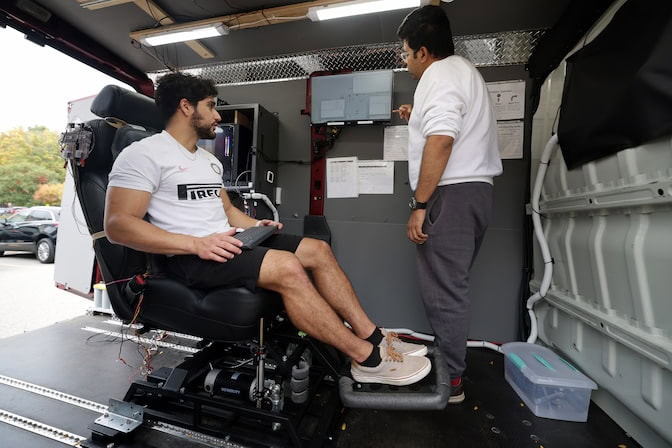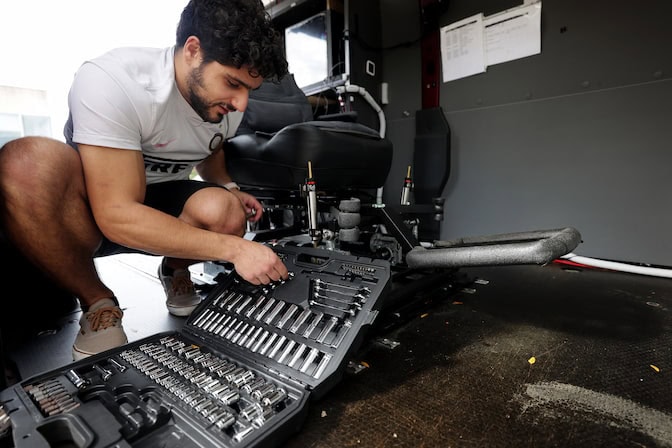
Motion sickness technology could alleviate symptoms for passengers in today’s cars, and tomorrow’s
New technology offers hope for those who get carsick.

New technology offers hope for those who get carsick.
Experts

Professor of Mechanical Engineering
Director of the Precision Systems Design Laboratory (PSDL)
Few weekends send more people on long car journeys than Memorial Day Weekend, with AAA estimating as many as 39 million people hitting the road this year. But unfortunately, motion sickness could make those trips uncomfortable and unpleasant for many people.

Transportation and mobility experts
work across disciplines to build a future
that’s safe, resilient and secure.
Engineers at the University of Michigan have developed a new technology, ready for implementation in current vehicles, that reduces motion sickness by nearly half. For the one out of every two children and one in three adults who suffer from the condition, it’s an option that comes without the drowsiness of medications.
U-M’s approach focuses on the cause of motion sickness—vehicle movements that catch passengers off-guard when they aren’t watching the road ahead. Called PREACT, the technology sends cues through the seat to alert those passengers to upcoming movements. It can also tilt the seat to mimic the way the body would naturally prepare for turning and braking if the passenger’s eyes were on the road to see what was coming.
Shorya: It’s well known that drivers of a vehicle don’t get motion sick, while passengers get motion sick.
Narrator: Motion sickness affects a third of adults and half of all children. On the road, the main reason for motion sickness in passengers is because they aren’t paying attention.
Daniel: When you’re looking at a static object inside of a moving vehicle, there is some confusion that happens inside of your brain because your eyes are processing that static object, but your inner ear is detecting motion as you’re moving inside of a vehicle.
Shorya: The driver of any vehicle knows what they’re doing. They’re the ones hitting the brake and turning the steering wheel for turns. Because of that knowledge, they make certain preemptive and very subtle corrections.
Narrator: This helps them avoid motion sickness. Unlike passengers, who cannot anticipate what’s coming and are unable to make similar adjustments.
With the development of autonomous vehicles, drivers will become passengers free to focus on other tasks during the ride. But this could make them more susceptible to motion sickness.
Over the past five years, Michigan Engineering researchers in the Precision Systems Design Lab have developed innovative technologies that can reduce the effects of motion sickness. Called Preact, it reduces these effects by monitoring the road ahead to either encourage or initiate a counter reaction for passengers.
Daniel: It’s to inform the person about what is about to happen to their body and prevent their brain from experiencing motion sickness.
Shorya: It is vitally important that we take into account the human factors associated with autonomous vehicles for autonomy to become the standard mode of transportation.
Narrator: Preact works by using predictive algorithms and sensors to generate data that can predict the vehicle’s movements.
Daniel: Once we make these predictions, we can determine what active corrections we want to do to provide the passenger with the most comfortable experience.
Shorya: In one implementation, the seat cushion can have embedded haptic motors, similar to those in cell phones for notifications.
Daniel: For example, if the car is about to make a left turn, we can vibrate the left side of the seat. This allows the passenger to anticipate the vehicle maneuvers and even take preemptive corrections themselves, like tightening their core muscles or leaning into the turn.
Shorya: In another implementation, the seats can have very gentle tilt motion capabilities.
Daniel: Instead of providing cues to the passenger, the active seat makes corrections for them. For instance, if the vehicle is about to make a left turn, the active seat will tilt the person to the left slightly before the turn to provide preemptive correction.
Shorya: So every human-driven vehicle with a passenger can benefit from this technology right now.
Daniel: The haptic solution is for those looking for an easy-to-use, plug-and-play motion sickness solution in their existing vehicle platform. The active seat, integrated into a vehicle platform, is for customers seeking motion sickness mitigation when buying a vehicle.
Narrator: The researchers are continuing to develop Preact under their newly formed startup, MotionSick, and they’ve begun collaborating with a major automotive manufacturer to implement the technology.
Daniel: We want to give riders the best possible experience inside the cabin and allow them to reclaim their commute time. Addressing motion sickness is crucial for achieving this goal.
“We call it PREACT because it predicts the motions of the vehicle and acts preemptively to counteract the effect of the vehicle’s motion on the passenger’s body,” said Shorya Awtar, a U-M professor of mechanical engineering and director of the Precision Systems Design Laboratory. “We take real-time and historical data from on-vehicle sensors to help anticipate the vehicle’s impending motions and use that to alert passengers to what’s coming.”

Following five years of research, technology innovations and extensive human testing, PREACT is now making its way toward real-world implementation.
In March, Awtar and Daniel Sousa Schulman, a PhD candidate and PREACT’s chief engineer, worked with U-M’s Innovation Partnerships to found Motion Sync, a high-tech startup seeking to commercialize the technology. Motion Sync has begun working with a major auto manufacturer—a partnership designed to explore and demonstrate PREACT’s viability for the automaker’s vehicles.
One version of the technology makes use of automatically tilting seats or tightening seat belts to prepare passengers for upcoming maneuvers. Such active seats and seatbelts would be integrated within the vehicle platform.
Another version of the PREACT technology can be retrofitted on any existing vehicle. In this case, PREACT sends haptic cues to passengers in advance of turns, acceleration and braking so that they aren’t caught off-guard by their vehicle’s movements. A buzzing on the left side of the seat warns the occupant to prepare for a left turn, for instance.

Schulman, Motion Sync’s CEO, said the retrofit haptic version adds only a few pounds to a vehicle, requires minimal power and comes at a low cost.
“Users will be able to choose whatever PREACT version works best for their needs, an integrated version versus a retrofit version,” he said. “This will make PREACT affordable and accessible to a wide range of customers.”
PREACT’s research team tested the technology with over 150 human subjects at Mcity, using specially designed test vehicles operating on test tracks that simulate both city and highway driving. Results showed a statistically significant reduction in the subjects’ feelings of motion sickness, with 80% saying it’s a technology they would want included with their next vehicle purchase.
PREACT would work in today’s human-driven vehicles, including electric and hybrid. Both charge batteries through regenerative braking, but this more aggressive deceleration leads to increases in motion sickness.

And, just like ridesharing services such as Uber and Lyft, PREACT could help autonomous vehicles deliver on their promise of turning commutes and longer journeys into work or leisure time, enabling passengers to take their eyes off the road without experiencing motion sickness.
“There are big questions out there–will users trust these autonomous vehicles, or will there be a level of discomfort for people in these vehicles,” Awtar said. “It’s vitally important we take into account the human factors associated with this if it’s to become the standard mode for transportation. Motion Sync is tackling some of these challenges and plans to have PREACT available to consumers in the near future.”
The research was partially funded by the US Department of Transportation’s Center for Connected and Automated Transportation (CCAT) and Michigan Translational Research and Commercialization (MTRAC) for Advanced Transportation Innovation Hub.